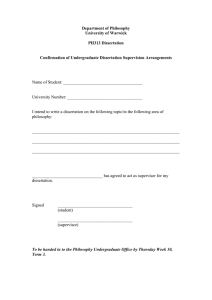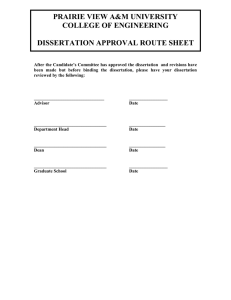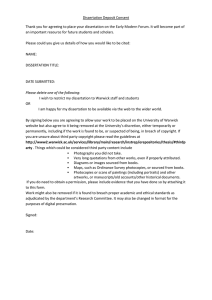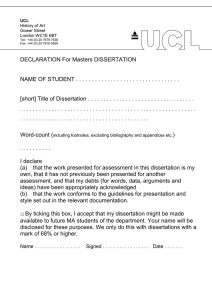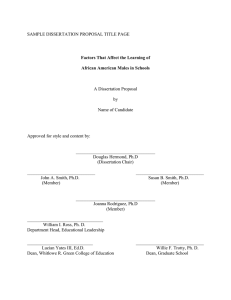The History Dissertation Introductory session Dissertation tutor:
advertisement
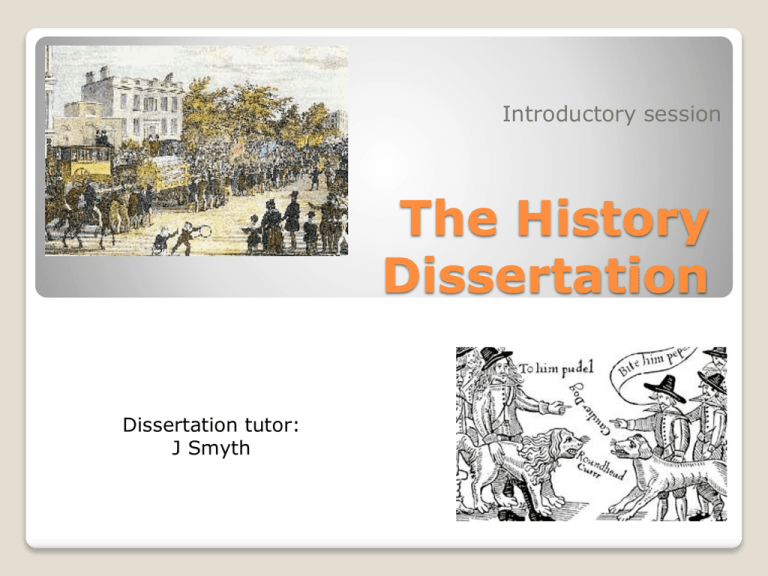
Introductory session The History Dissertation Dissertation tutor: J Smyth Main Features of the Dissertation • The dissertation is compulsory for all History single honours final-year students: it is also available as an option for all joint degree students. It is weighted at 30 CATS. • The dissertation must be based on a final-year History or CAS module that you are enrolled on this year (not in any previous year), whether an Advanced Option, a Special Subject or the ‘Historiography’ Module. • Joint degree students who wish to do a History dissertation have to be doing also a Special Subject in History and/or Advanced Option in History in their final year, and the dissertation will be linked to either. • The dissertation length is 9,000 words, excluding footnotes and bibliography. The penalty for any further overshoot is a deduction of 1 mark for each 100 words, or part thereof, over 9,000 words. • An outline of what is required can be found on the History website: http://www2.warwick.ac.uk/fac/arts/history/undergraduate/modules/dissertation • More detail will be found in handbook, which you should read as soon as possible. http://www2.warwick.ac.uk/fac/arts/history/undergraduate/modules/dissertation/guida nce Term 1 Lectures There will be 4 one-hour talks and sessions. They will be held at the same time and place as today’s lecture (1-2pm Tuesday evenings in the Arts Ctr Conference Room) Tuesday, 6 October 2015: 1-2pm. Introduction by the module director. Tuesday, 13 October 2015: 1-2pm. Accessing primary sources and archives, Dr Laura Schwartz. Tuesday, 20 October 2015: 1-2pm. Oral History, Prof. Dan Branch. Tuesday, 27 October 2015: 1-2pm. Writing it up – the process of organising material and putting it into a coherent and well-argued whole – Prof. Mark Philp. Term 2 Term 2, weeks 1-3, times TBA. Sign up for a time slot outside room H328 to meet with Dr Smyth to discuss your research progress as needed. You will meet in small clusters, deliver a short (5 minute) presentation of your work so far, and receive group feedback. You can bring a printed plan to distribute to the group if you wish. You will be engaging here in a process similar to that of the academic research seminar, in which you present a topic and argument and discover its strengths and weaknesses through discussion. Supervisor • Each of you will receive regular personal guidance from a supervisor throughout the dissertation process. • The supervisor will be the tutor for the module that you are situating the dissertation in. • Your first port of call should be your supervisor. In most cases you will not need to consult any other member of staff. • The supervisor will help you establish a topic and suggest suitable reading and primary sources. They will comment on any plans or outlines that you produce. Make sure that you make good use of your supervisor – don’t hesitate to ask for supervision meetings. First task • Start thinking about which module you want to base your dissertation in, and what aspect of that module particularly interests you. • It is recommended that you base it in your Special Subject, as this provides you plenty of access to the sort of primary sources that are expected in a dissertation. • However, you may decide to base it in your advanced option, or in historiography. Researching a Dissertation Your dissertation supervisor should be able to help you with this, once you have decided on a suitable topic and approach. You need to bear in mind that both secondary and primary materials are likely to be involved. Sources Secondary: Work in print (normally), such as articles in journals, essays in edited collections, books, and so on. You will need these to provide the background, to aid you in framing your research questions, your introduction and conclusion. The historiography of your topic is likely to be a significant part of the dissertation and this will come from the secondary literature. Primary: Are far more varied. Some of you will be looking at a set of them in connection with your Special Subject; you may also have encountered examples elsewhere in your History modules. Primary sources might include: newspapers, memoirs, correspondence (published and unpublished), Parliamentary Papers, archival records relating to organizations and institutions (the Modern Records Centre on campus has examples of these which you can access via the University of Warwick Library website), literary texts (such as novels and plays), early modern political and religious tracts, contemporary medical texts, or oral and visual source materials (interviews, photographs, paintings etc.). Modern Records Centre, Warwick University You can access information on the holding of the MRC via the University of Warwick Library website. Resources outside Warwick • Other libraries (especially university libraries): many of these have online catalogues. Many have attached archives, like the MRC. You might also want to visit a university library elsewhere and for this you can obtain a SCONUL card from the Warwick University Library that will give you free admission (again see the Library’s webpage for information on this). • British Library; National Archives, Kew; BBC archives; British Film Institute. • Local archives: such as county record offices. Warwick County Archives are, for example, located in Warwick town. This can be very rewarding but it is time-consuming (and in terms of travel and somewhere to stay) can be expensive. Oral History through Interviews • You may interview people about past events. This is known as ‘oral history’. The recorded or transcribed interview is considered to be a primary resource – in this case you are creating your own archive. You should make recordings of your interviews if possible, or take detailed notes, and reference these in your dissertation as you would any primary source. • There are certain ethics of research involved here. You need to obtain consent from the person being interviewed before taking notes or recording them. You should not do anything that will have a detrimental impact on anyone whom you are interviewing. You should be very scrupulous in this respect. • In a few cases, such work involves dealing with sensitive issues. If you feel that this might be the case you should discuss the issue with your supervisor beforehand and get appropriate advice. It may be necessary to fill out an Undergraduate Research Ethics Form. Originality • What can you say that is new about a given topic? • Originality really signifies one or two things – or both: • Opening up a new line of enquiry that no-one else seems to have thought of. • Going back to the existing historiography and giving it a new twist. In this case it is likely to be your ability to reinterpret the existing material, to point out its flaws and limitations, and present logically and clearly a new case that is important. • Commonly, it entails looking for some new source – a collection of letters, or a first-hand account of some kind – that adds a new dimension to an existing field of scholarship or which tackles a topic that no-one seems to have looked at before or thought to be of much importance. The process of writing a dissertation (1) You will start with a topic that interests you. Hopefully, you will have a question about it. You should certainly set about raising questions as soon as possible. For example, why did such-and-such happen in suchand-such a way? Or, why is an existing historical interpretation unsatisfactory, in your opinion? You try to answer each question with a hypothesis. As you continue your reading and the research, you should constantly revise the hypothesis in the light of what you have found. After carrying out the research, you have to organise your material and write it up. You will probably need to write a couple of drafts, or substantially revise parts of the work, before it is ready for submission. By the end of the dissertation, you should be satisfied that you have adequately addressed and answered the question that you started out with. The process of writing a dissertation (1) It helps if you structure your dissertation into different sections. 1. Introduction, which sets out the topic, identifies what others have written on this topic, debates about the subject. You should make it clear which aspects of the topic that you are (or are not) going to address. This need only be a couple of paragraphs in length, but it is important to try to get the tone right and to interest your reader in what follows. 2. Sections or Chapters (These can be given a brief title or merely numbered). Each covers a particular aspect of the wider topic and they should progress logically from one to the other. In a dissertation of 9,000 words you might have 3 or 4 or 5 of these. This should help you and your readers to think more clearly about the natural divisions of the topic, the stages in your argument and the balance between different strands of interpretation and documentation. 3. Conclusion. This might be rather shorter than the introduction, but it should be a conclusion rather than a summary: what have you proved or shown? References You must reference your material through footnotes. You should also have a bibliography of all works consulted at the end of the dissertation. Check on how to do this in the ‘Undergraduate Style Guide’. Also, see how other historians use footnotes. Proper citation is necessary to avoid any impression of plagiarism. Do not include too many footnotes or make them too long, or use the footnotes to go off on a tangent. Although footnotes are not included in the word limit, you can be marked down for having over-long footnotes that contain material that could be in the main text. Keep quotations in the text relatively short so as to leave adequate room for your analysis and interpretation. Or, if you think a long passage is warranted, make sure that you analyse it: don’t assume that its meaning and significance is self-evident. Writing-up • Do not underestimate the writing-up time you are likely to need. You will probably need to write a couple of drafts, or substantially revise parts of the work, before it is ready for submission. • You will probably write more than 9,000-words to start with. You will then have to cut it down. You will probably have to cut out some material and even whole paragraphs and sub-topics. Though painful, you will have to be ruthless at this point. Such editing is a good skill to learn. The end result, if done well, is normally a tighter and better piece of work. • Don’t forget to leave enough time to proof-read your work: your examiners will not be impressed if your spelling is incorrect or inconsistent or you have clearly not bothered to check dates or obvious facts. You may lose marks if you don’t pay attention to this kind of detail. Timetable – term 1 • Term 1. Identify a suitable topic and supervisor. • End of Term 1. By the end of the Autumn term (term one) complete a preliminary online statement: the current History module in connection with which they intend to research and write their dissertation their intended dissertation topic and supervisor • Link as follows: http://www2.warwick.ac.uk/fac/arts/history/undergraduate/modules/dissertatio n/topic/ Timetable – submission process in term 3 • Dissertations are to be submitted in word-processed form both online and in hard copy. They should be anonymised, with only your student number on the title page. They do not need to be bound, only stapled. The copies that you submit will be retained for examination purposes and will not be returned to you. • The hard copy should be submitted to the undergraduate secretary, Jennifer Spalding, in her office (room H342) by 12.0 noon on the Monday of week 2 of the Summer term (term three). • Late submission will be penalised. The rule is as follows: ‘Where an extension has not been granted, or where an extension request did not reach the Director of Undergraduate Studies before the deadline for the assessed work, such assessed essays handed in late will be subject to a penalty of 5 percentage marks per working day’. Enjoy the work!
